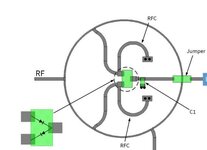tony_lth
Advanced Member level 5
Hi, Gurus,
I met this mixer circuit, as the following picture.
I have several questions:
1. What is the RFC for?
2. If for matching the input of diodes, why it is in the root of the pin? And the diodes input impedance should be varied by the freq and input LO power level, right?
Best,
Tony Liu
I met this mixer circuit, as the following picture.
I have several questions:
1. What is the RFC for?
2. If for matching the input of diodes, why it is in the root of the pin? And the diodes input impedance should be varied by the freq and input LO power level, right?
Best,
Tony Liu
